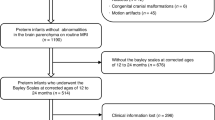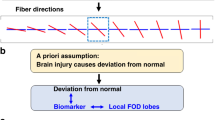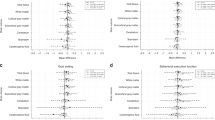Abstract
Background
Preterm born children are at high risk for adverse motor neurodevelopment. The aim of this study was to establish the relationship between motor outcome and advanced magnetic resonance imaging (MRI) and electroencephalography (EEG) measures.
Methods
In a prospective cohort study of 64 very preterm born children, the motor outcome was assessed at 9.83 (SD 0.70) years. Volumetric MRI, diffusion tensor imaging (DTI), and EEG were acquired at 10.85 (SD 0.49) years. We investigated associations between motor outcome and brain volumes (white matter, deep gray matter, cerebellum, and ventricles), white matter integrity (fractional anisotropy and mean, axial and radial diffusivity), and brain activity (upper alpha (A2) functional connectivity and relative A2 power). The independence of associations with motor outcome was investigated with a final model. For each technique, the measure with the strongest association was selected to avoid multicollinearity.
Results
Ventricular volume, radial diffusivity, mean diffusivity, relative A2 power, and A2 functional connectivity were significantly correlated to motor outcome. The final model showed that ventricular volume and relative A2 power were independently associated with motor outcome (B = −9.42 × 10−5, p = 0.027 and B = 28.9, p = 0.007, respectively).
Conclusions
This study suggests that a lasting interplay exists between brain structure and function that might underlie motor outcome at school age.
Impact
-
This is the first study that investigates the relationships between motor outcome and brain volumes, DTI, and brain function in preterm born children at school age.
-
Ventricular volume and relative upper alpha power on EEG have an independent relation with motor outcome in preterm born children at school age.
-
This suggests that there is a lasting interplay between structure and function that underlies adverse motor outcome.
Similar content being viewed by others
Log in or create a free account to read this content
Gain free access to this article, as well as selected content from this journal and more on nature.com
or
Change history
25 June 2021
The name of the the first author was corrected.
References
Helenius, K. et al. Survival in very preterm infants: an International Comparison of 10 National Neonatal Networks. Pediatrics 140, e20171264 (2017).
Parikh, N. A. Advanced neuroimaging and its role in predicting neurodevelopmental outcomes in very preterm infants. Semin. Perinatol. 40, 530–541 (2016).
Taylor, M. J. Structure and function: how to connect? Neuroradiology 55, 55–64 (2013).
Volpe, J. J. Brain injury in premature infants: a complex amalgam of destructive and developmental disturbances. Lancet Neurol. 8, 110–124 (2009).
Anderson, P. J., Cheong, J. L. & Thompson, D. K. The predictive validity of neonatal MRI for neurodevelopmental outcome in very preterm children. Semin. Perinatol. 39, 147–158 (2015).
Mathur, A. M., Neil, J. J. & Inder, T. E. Understanding brain injury and neurodevelopmental disabilities in the preterm infant: the evolving role of advanced magnetic resonance imaging. Semin. Perinatol. 34, 57–66 (2010).
de Kieviet, J. F. et al. Brain development of very preterm and very low-birthweight children in childhood and adolescence: a meta-analysis. Dev. Med. Child Neurol. 54, 313–323 (2012).
Nosarti, C. et al. Grey and white matter distribution in very preterm adolescents mediates neurodevelopmental outcome. Brain 131, 205–217 (2008).
Nosarti, C. et al. Preterm birth and structural brain alterations in early adulthood. Neuroimage Clin. 6, 180–191 (2014).
Whitford, T. J. et al. Brain maturation in adolescence: concurrent changes in neuroanatomy and neurophysiology. Hum. Brain Mapp. 28, 228–237 (2007).
C, van‘tWestende et al. The degree of prematurity affects functional brain activity in preterm born children at school-age: an EEG study. Early Hum. Dev. 148, 105096 (2020).
Twilhaar, E. S. et al. EEG profiles and associated neurodevelopmental outcomes after very preterm birth. Clin. Neurophysiol. 130, 1166–1171 (2019).
Melhem, E. R. et al. Diffusion tensor MR imaging of the brain and white matter tractography. Am. J. Roentgenol. 178, 3–16 (2002).
Beaulieu, C. The basis of anisotropic water diffusion in the nervous system - a technical review. NMR Biomed. 15, 435–455 (2002).
Andica, C. et al. MR biomarkers of degenerative brain disorders derived from diffusion imaging. J. Magn. Reson. Imaging. 52, 1620–1636 (2019).
Kwon, S. H. et al. Functional magnetic resonance connectivity studies in infants born preterm: suggestions of proximate and long-lasting changes in language organization. Dev. Med. Child Neurol. 58, 28–34 (2016).
Pandit, A. S., Ball, G., Edwards, A. D. & Counsell, S. J. Diffusion magnetic resonance imaging in preterm brain injury. Neuroradiology 55, 65–95 (2013).
Gano, D. White matter injury in premature newborns. Neonatal Netw. 35, 73–77 (2016).
Huang, H. Structure of the fetal brain: what we are learning from diffusion tensor imaging. Neuroscientist 16, 634–649 (2010).
Xu, D., Mukherjee, P. & Barkovich, A. J. Pediatric brain injury: can DTI scalars predict functional outcome? Pediatr. Radiol. 43, 55–59 (2013).
Pecheva, D. et al. Recent advances in diffusion neuroimaging: applications in the developing preterm brain. F1000Res 7, F1000FacultyRev-1326 (2018).
Li, K. et al. Fractional anisotropy alterations in individuals born preterm: a diffusion tensor imaging meta-analysis. Dev. Med. Child Neurol. 57, 328–338 (2015).
de Kieviet, J. F. et al. A crucial role of altered fractional anisotropy in motor problems of very preterm children. Eur. J. Paediatr. Neurol. 18, 126–133 (2014).
Hinojosa-Rodriguez, M. et al. Clinical neuroimaging in the preterm infant: diagnosis and prognosis. Neuroimage Clin. 16, 355–368 (2017).
Sui, J. et al. Function-structure associations of the brain: evidence from multimodal connectivity and covariance studies. Neuroimage 102, 11–23 (2014).
de Bruine, F. T. et al. Prognostic value of gradient echo T2* sequences for brain MR imaging in preterm infants. Pediatr. Radiol. 44, 305–312 (2014).
Leijser, L. M. et al. Brain imaging findings in very preterm infants throughout the neonatal period: part I. Incidences and evolution of lesions, comparison between ultrasound and MRI. Early Hum. Dev. 85, 101–109 (2009).
Bancalari, E. & Claure, N. Definitions and diagnostic criteria for bronchopulmonary dysplasia. Semin. Perinatol. 30, 164–170 (2006).
Bell, M. J. et al. Neonatal necrotizing enterocolitis. Therapeutic decisions based upon clinical staging. Ann. Surg. 187, 1–7 (1978).
Hoftiezer, L. et al. From population reference to national standard: new and improved birthweight charts. Am. J. Obstet. Gynecol. 220, 383 e381–383.e317 (2019).
Volpe, J. J. Volpe’s Neurology of the Newborn (Elsevier, 2018).
Kidokoro, H., Neil, J. J. & Inder, T. E. New MR imaging assessment tool to define brain abnormalities in very preterm infants at term. Am. J. Neuroradiol. 34, 2208–2214 (2013).
Dale, A. M., Fischl, B. & Sereno, M. I. Cortical surface-based analysis. I. Segmentation and surface reconstruction. Neuroimage 9, 179–194 (1999).
Fischl, B., Sereno, M. I. & Dale, A. M. Cortical surface-based analysis. II: Inflation, flattening, and a surface-based coordinate system. Neuroimage 9, 195–207 (1999).
Smith, S. M. et al. Tract-based spatial statistics: voxelwise analysis of multi-subject diffusion data. NeuroImage 31, 1487–1505 (2006).
Ball, G. et al. An optimised tract-based spatial statistics protocol for neonates: applications to prematurity and chronic lung disease. Neuroimage 53, 94–102 (2010).
Stam, C. J., Nolte, G. & Daffertshofer, A. Phase lag index: assessment of functional connectivity from multi channel EEG and MEG with diminished bias from common sources. Hum. Brain Mapp. 28, 1178–1193 (2007).
Field, A. P. Discovering Statistics Using SPSS (and Sex and Drugs and Rock ‘n’ Roll) (SAGE, 2009).
Benjamini, Y. & Hochberg, Y. Controlling the false discovery rate: a practical and powerful approach to multiple testing. J. R. Stat. Soc. Ser. B 57, 289–300 (1995).
Uludag, K. & Roebroeck, A. General overview on the merits of multimodal neuroimaging data fusion. Neuroimage 102, 3–10 (2014).
Keunen, K. et al. Brain volumes at term-equivalent age in preterm infants: imaging biomarkers for neurodevelopmental outcome through early school age. J. Pediatr. 172, 88–95 (2016).
Thompson, D. K. et al. Regional white matter microstructure in very preterm infants: predictors and 7 year outcomes. Cortex 52, 60–74 (2014).
Allin, M. et al. Effects of very low birthweight on brain structure in adulthood. Dev. Med. Child Neurol. 46, 46–53 (2004).
Brouwer, M. J. et al. Sequential cranial ultrasound and cerebellar diffusion weighted imaging contribute to the early prognosis of neurodevelopmental outcome in preterm infants. PLoS ONE 9, e109556 (2014).
Volpe, J. J., Kinney, H. C., Jensen, F. E. & Rosenberg, P. A. The developing oligodendrocyte: key cellular target in brain injury in the premature infant. Int. J. Dev. Neurosci. 29, 423–440 (2011).
Gonzalez, J. J. et al. Assessment of electroencephalographic functional connectivity in term and preterm neonates. Clin. Neurophysiol. 122, 696–702 (2011).
Scher, M. S. et al. Comparisons of EEG spectral and correlation measures between healthy term and preterm infants. Pediatr. Neurol. 10, 104–108 (1994).
Suppiej, A. et al. Spectral analysis highlight developmental EEG changes in preterm infants without overt brain damage. Neurosci. Lett. 649, 112–115 (2017).
Yerushalmy-Feler, A. et al. Electroencephalographic characteristics in preterm infants born with intrauterine growth restriction. J. Pediatr. 164, 756–761.e751 (2014).
Shellhaas, R. A. et al. Neonatal sleep-wake analyses predict 18-month neurodevelopmental outcomes. Sleep 40, zsx144 (2017).
Doesburg, S. M. et al. Magnetoencephalography reveals slowing of resting peak oscillatory frequency in children born very preterm. Pediatr. Res. 70, 171–175 (2011).
Doesburg, S. M. et al. Region-specific slowing of alpha oscillations is associated with visual-perceptual abilities in children born very preterm. Front. Hum. Neurosci. 7, 791 (2013).
Gaubert, S. et al. EEG evidence of compensatory mechanisms in preclinical Alzheimer’s disease. Brain 142, 2096–2112 (2019).
Peterson, D. S. & Fling, B. W. How changes in brain activity and connectivity are associated with motor performance in people with MS. Neuroimage Clin. 17, 153–162 (2018).
Acknowledgements
The Department of Neonatology received a grant from Chiesi Pharmaceuticals B.V. Schiphol, The Netherlands for the execution of this study. We wish to thank R.J.M. Berkhout for her assistance during the data collection of the study. We would also like to thank all the technicians of the laboratory of the Clinical Neurophysiology and Radiology Department of the Leiden University Medical Center. We thank J. Lak and R. van Leeuwen for the assistance with the acquisition of the EEG and MRI data and the guidance of the patients and their parents, and Prof. Dr. Linda de Vries for carefully reviewing the current manuscript. All authors meet the authorship requirements. S.J.S. received a grant from Chiesi Pharmaceuticals B.V. Schiphol, The Netherlands for the execution of this study. Chiesi Pharmaceuticals B.V. was not involved in the conduct of the research.
Author information
Authors and Affiliations
Contributions
C.v.W.: conceptualization, methodology, formal analysis, investigation, writing—original draft, visualization; S.J.S.: conceptualization, data acquisition, methodology, writing—review and editing, supervision, project administration, funding acquisition; L.J.: conceptualization, methodology, writing—review and editing, project administration; A.A.v.d.B.-H.: conceptualization, methodology, formal analysis, investigation, data curation, writing—review and editing L.A.v.d.P.: writing—review and editing, supervision; F.T.W.-d.B.: conceptualization, data acquisition, methodology, writing—review & editing; C.J.S.: software, writing—review and editing, supervision; C.M.P.C.D.P.-S.: conceptualization, data acquisition, methodology, writing—review and editing, supervision, project administration.
Corresponding author
Ethics declarations
Competing interests
C.M.P.C.D.P.-S. is founder and consultant at Neurophyxia BV. She holds several patents and stocks of Neurophyxia BV. None of this work has a relationship with the current manuscript. The other authors declare no competing interests.
Consent statement
Written consent was obtained from both parents, and all children received age-specific information about the study.
Additional information
Publisher’s note Springer Nature remains neutral with regard to jurisdictional claims in published maps and institutional affiliations.
Rights and permissions
About this article
Cite this article
van ’t Westende, C., Steggerda, S.J., Jansen, L. et al. Combining advanced MRI and EEG techniques better explains long-term motor outcome after very preterm birth. Pediatr Res 91, 1874–1881 (2022). https://doi.org/10.1038/s41390-021-01571-x
Received:
Revised:
Accepted:
Published:
Issue date:
DOI: https://doi.org/10.1038/s41390-021-01571-x



